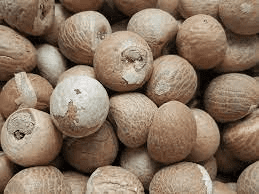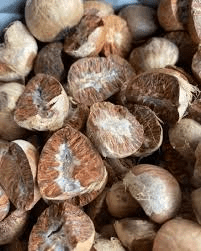Areca nut, scientifically known as Areca catechu, is the seed of the areca palm tree, which is native to Southeast Asia. It is commonly referred to as betel nut due to its widespread use in conjunction with betel leaves for chewing in many Asian cultures. The areca palm is a species of palm tree that produces large, feathery fronds and grows in tropical climates.
The areca nut itself is a hard, seed-like fruit, usually about the size of a small plum. It has a distinct reddish-brown color and is enclosed in a fibrous husk. The nut contains various bioactive compounds, including alkaloids such as arecoline, which contributes to its stimulant properties.
Traditionally, the areca nut is chewed with betel leaves and often combined with slaked lime (calcium hydroxide) and sometimes other flavorings like tobacco. This combination is known as “betel quid” and has cultural and social significance in certain communities.
However, the habit of chewing areca nut has been associated with various health risks, including oral cancer and other adverse effects on oral health.
In addition to its use in traditional practices, areca nut extracts have been studied for potential pharmacological properties, such as antimicrobial and antioxidant activities. Nevertheless, the health risks associated with the consumption of areca nut, particularly in the form of betel quid, underscore the importance of understanding its potential impact on human health.
The Botanical Description of Areca Nut
1. Shape and Size: Areca nut, scientifically known as Areca catechu, is the seed of the Areca palm, typically round or oval, measuring about 1.5 to 2.5 centimeters in diameter.
2. Color and Texture: The nut’s outer covering, called the pericarp, varies in color, ranging from green when young to a reddish or yellowish hue as it matures. The texture is smooth and firm.
3. Structure and Layers: Internally, the Areca nut is composed of distinct layers – the endocarp surrounds the seed, followed by the seed coat and the embryo, contributing to the overall structure.
4. Areca Palm Characteristics: The Areca palm, bearing the Areca nut, is an attractive, slender, and tall palm tree with feathery leaves. The nuts grow in clusters on the palm’s branches.
5. Growth and Reproduction: Areca nuts develop within the fruit of the female Areca palm, with palms being dioecious. Successful pollination leads to nut production.
6. Aromatic Properties: One notable aspect is the nut’s aromatic nature. When chewed or processed, it releases a distinct, earthy fragrance, contributing to its cultural significance.
The Geographic Distribution of Areca Nut

1. Native Regions: The Areca palm, and consequently the Areca nut, is native to the Malay Archipelago and the tropical regions of Southeast Asia, thriving in warm, humid climates.
2. Subtropical and Tropical Zones: Due to its preference for subtropical and tropical climates, the Areca palm is commonly found in regions with temperatures above freezing and abundant rainfall.
3. Global Spread: While native to Southeast Asia, the Areca palm has been introduced and cultivated in various parts of the world, including Africa, the Middle East, India, and the Pacific Islands.
4. Soil Preferences: The Areca palm prefers well-draining soil, often thriving in sandy or loamy soils. It can adapt to different soil types but requires proper drainage.
5. Altitude Considerations: Areca palms typically grow at lower elevations, favoring altitudes from sea level up to around 1,000 meters for optimal growth.
6. Cultivation and Economic Significance: Given its adaptability to various tropical regions, the Areca palm is cultivated for its economic significance, contributing to the global availability of Areca nuts.
The Chemical Composition of Areca Nut
1. Alkaloids: Areca nuts contain alkaloids, with arecoline being the primary psychoactive compound, known for its stimulant effects on the central nervous system.
2. Tannins: Tannins are present, contributing to the nut’s astringent taste and possessing antioxidant properties.
3. Polyphenols: Polyphenolic compounds, including catechins, are found, contributing to potential antioxidant and anti-inflammatory effects.
4. Proteins and Fats: Areca nuts contain proteins and fats, providing a source of energy. Composition may vary depending on the nut’s maturity.
5. Minerals: Calcium, phosphorus, and iron are present, contributing to the nut’s nutritional profile.
6. Carbohydrates: The nut contains carbohydrates, including sugars and fibers, contributing to its caloric value.
7. Essential Oils: Areca nuts contain essential oils, released when chewed or processed, contributing to the nut’s aromatic properties.
8. Flavonoids: Flavonoids, known for antioxidant properties, are also part of the chemical composition of Areca nuts.
Read Also: Worm Infestation on Ruminant Animals: Symptoms and Treatment
The Medicinal Health Benefits Of Areca Nut (Betel Nut)

1. Digestive Aid: Areca nut, also known as Betel Nut, has been traditionally used as a digestive aid, promoting the secretion of digestive enzymes and facilitating smooth digestion.
2. Anti-Inflammatory Properties: The nut exhibits anti-inflammatory properties, potentially alleviating inflammation-related conditions and providing relief.
3. Antimicrobial Effects: Studies suggest that Areca nut possesses antimicrobial effects, aiding in combating certain bacteria and fungi.
4. Oral Health Improvement: Chewing Areca nut is believed to contribute to oral health by promoting saliva production and maintaining oral hygiene.
5. Respiratory Support: In some traditional practices, Areca nut has been used to support respiratory health and address symptoms of respiratory conditions.
6. Aphrodisiac Properties: Certain cultures attribute aphrodisiac properties to Areca nut, suggesting its potential influence on sexual health.
7. Mental Alertness: The nut is thought to have stimulant effects, contributing to increased mental alertness and reduced fatigue.
8. Stress Reduction: Areca nut consumption has been associated with stress reduction and relaxation in some traditional practices.
9. Potential Anti-Cancer Properties: Some studies explore the potential anti-cancer properties of Areca nut, particularly in relation to certain types of cancer cells.
10. Weight Management: In traditional medicine, Areca nut is believed to aid in weight management, possibly due to its effects on metabolism.
11. Antioxidant Benefits: The nut contains antioxidants that may help neutralize free radicals, contributing to overall health.
12. Cardiovascular Support: Certain compounds in Areca nut may have cardiovascular benefits, supporting heart health.
13. Analgesic Effects: Traditional uses suggest that Areca nut may have analgesic effects, providing relief from pain.
14. Anti-Diabetic Potential: Some studies hint at the anti-diabetic potential of Areca nut, showcasing its influence on glucose regulation.
15. Anti-Helminthic Properties: Areca nut has been traditionally used for its potential anti-helminthic properties, addressing certain parasitic infections.
16. Wound Healing: Topical application of Areca nut paste has been explored for its potential in promoting wound healing.
The Methods of Usage to Achieve the Provided Health Benefits Of Areca Nut (Betel Nut)
1. Chewing Raw Areca Nut: One of the most common methods is chewing raw Areca nut, often with other ingredients like betel leaf and slaked lime. This method is prevalent in many cultures.
2. Infusions and Decoctions: Areca nut can be used to prepare infusions or decoctions, allowing the extraction of its beneficial compounds. These can be consumed as teas.
3. Topical Applications: In some cases, Areca nut paste is applied topically to address skin conditions or promote wound healing.
4. Areca Nut Powder: Ground Areca nut can be consumed in powdered form, often mixed with other herbs or taken with honey.
5. Traditional Formulations: Areca nut is incorporated into various traditional formulations, combining it with other medicinal herbs for specific health benefits.
6. Dietary Supplement: Areca nut extracts are sometimes used as a dietary supplement, offering a concentrated form of its beneficial compounds.
7. Ayurvedic Practices: Ayurvedic medicine utilizes Areca nut in specific formulations and practices tailored to individual health needs.
8. Smoking Mixtures: In certain cultures, Areca nut is included in smoking mixtures, although this method is associated with potential health risks.
The Side Effects Of Using Areca Nut Medicinal Plant
1. Oral Health Risks: Chewing Areca nut has been linked to oral health risks, including the potential for gum disease and tooth decay.
2. Carcinogenic Concerns: Long-term use of Areca nut, especially in combination with other ingredients, has raised concerns about its potential carcinogenic effects.
3. Addiction and Dependence: Regular consumption of Areca nut may lead to addiction and dependence, impacting overall well-being.
4. Gastrointestinal Issues: Excessive consumption can result in gastrointestinal issues, including nausea, vomiting, and stomach discomfort.
5. Cardiovascular Effects: Some studies suggest that prolonged use of Areca nut may have cardiovascular effects, affecting blood pressure and heart health.
6. Reproductive Health Concerns: Areca nut has been associated with potential adverse effects on reproductive health, including concerns related to fertility.
7. Neurological Impact: Compounds in Areca nut, such as arecoline, may have neurological effects, contributing to concerns about cognitive function.
8. Respiratory Distress: In rare cases, inhalation of excessive amounts of Areca nut may lead to respiratory distress.
Read Also: Gooseberries: History, Nutrition, Health Benefits and Growing Guide
The Scientific Research and Studies of Artemisia herba-alba

1. Anti-Inflammatory Effects: Scientific research has delved into the anti-inflammatory effects of Artemisia herba-alba, demonstrating its potential in managing conditions associated with inflammation, such as arthritis and inflammatory bowel diseases.
2. Antioxidant Properties: Studies have explored the antioxidant properties of Artemisia herba-alba, highlighting its role in neutralizing free radicals and reducing oxidative stress in the body.
3. Antimicrobial Activity: Scientific investigations have assessed the antimicrobial activity of Artemisia herba-alba, exploring its potential in combating bacterial and fungal infections.
4. Neuroprotective Potential: Research has suggested that certain compounds in Artemisia herba-alba may have neuroprotective effects, indicating possible benefits for neurological health.
5. Anti-cancer Properties: Studies are ongoing to explore the potential anti-cancer properties of Artemisia herba-alba, investigating its effects on various types of cancer cells.
6. Immunomodulatory Effects: Scientific studies have examined the immunomodulatory effects of Artemisia herba-alba, shedding light on its influence on the immune system’s response to challenges.
7. Clinical Trials on Human Subjects: Some studies have progressed to clinical trials, assessing the safety and efficacy of Artemisia herba-alba in human subjects, providing valuable insights into its potential therapeutic applications.
The Safety Precautions and Recommendations In Using Artemisia herba-alba Medicinal Plant
1. Allergic Reactions: Individuals with known allergies to plants in the Asteraceae family should exercise caution when using Artemisia herba-alba, as allergic reactions may occur.
2. Dosage Moderation: It is crucial to adhere to recommended dosages of Artemisia herba-alba, as excessive consumption may lead to adverse effects such as gastrointestinal distress.
3. Skin Sensitivity: For topical applications, individuals with sensitive skin should perform a patch test to avoid potential skin irritation from Artemisia herba-alba.
4. Pregnancy Precautions: Pregnant individuals should consult healthcare professionals before using Artemisia herba-alba due to potential uterine-stimulating effects.
5. Drug Interaction Awareness: Those taking medications should be aware of potential interactions, as Artemisia herba-alba may impact the effectiveness of certain drugs.
6. Monitoring Blood Sugar Levels: Individuals with diabetes should closely monitor their blood sugar levels when using Artemisia herba-alba, as it may influence glucose regulation.
7. Liver Health Consideration: Excessive or prolonged use of Artemisia herba-alba may impact liver function, necessitating moderation in usage and consultation with healthcare providers.
8. Central Nervous System Effects: Compounds like thujone in Artemisia herba-alba may affect the central nervous system; users should be cautious about potential dizziness or headaches.
9. Photosensitivity Caution: Some individuals may experience increased sensitivity to sunlight when using Artemisia herba-alba topically, warranting sun protection measures.
10. Pregnancy and Breastfeeding Avoidance: To avoid potential risks, pregnant and breastfeeding individuals are generally advised to refrain from using Artemisia herba-alba.
11. Consultation with Healthcare Professionals: Before incorporating Artemisia herba-alba into health routines, individuals with pre-existing conditions or concerns should seek advice from healthcare professionals.
12. Periodic Review of Usage: Regularly reviewing the usage of Artemisia herba-alba and its effects on individual health is essential for ongoing safety and well-being.
FAQs About Artemisia herba-alba Medicinal Plant
1. Is Artemisia herba-alba safe for pregnant women?
Pregnant women are generally advised to avoid Artemisia herba-alba due to potential uterine-stimulating effects.
2. Can Artemisia herba-alba be used for children?
It is recommended to consult with healthcare professionals before using Artemisia herba-alba for children.
3. What precautions should be taken for individuals with allergies?
Individuals with known allergies to plants in the Asteraceae family should use Artemisia herba-alba with caution to prevent allergic reactions.
4. Are there any known drug interactions with Artemisia herba-alba?
Artemisia herba-alba may interact with certain medications, impacting their effectiveness; it is advisable to consult healthcare providers.
5. How does Artemisia herba-alba impact blood sugar levels?
Individuals with diabetes should monitor their blood sugar levels closely when using Artemisia herba-alba, as it may influence glucose regulation.
6. Can Artemisia herba-alba be used topically?
Artemisia herba-alba can be used topically, but individuals with sensitive skin should perform a patch test to avoid potential irritation.
Read Also:
